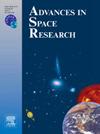An image simulator of lunar far-side impact flashes captured from the Earth-Moon L2 point
IF 2.8
3区 地球科学
Q2 ASTRONOMY & ASTROPHYSICS
引用次数: 0
Abstract
Impact flashes on the moon are caused by high-speed collisions of celestial bodies with the lunar surface. The study of the impacts is critical for exploring the evolutionary history and formation of the Moon, and for quantifying the risk posed by the impacts to future human activity. Although the impacts have been monitored from the Earth by a few projects in past 20 years, the events occurring on the lunar far side have not been explored systematically so far. We here present an end-to-end image simulator dedicated to detecting and monitoring the impacts from space, which is useful for future mission design. The simulator is designed for modularity and developed in the Python environment, which is mainly composed of four components: the flash temporal radiation, the background emission, the telescope and the detector used to collect and measure the radiation. Briefly speaking, with a set of input parameters, the simulator calculates the flash radiation in the context of the spherical droplet model and the background emission from the lunar surface. The resulting images are then generated by the simulator after considering a series observational effects, including the stray light, transmission of the instrument, point spread function and multiple kinds of noise caused by a CCD/CMOS detector. The simulator is validated by comparing the calculation with the observations taken on the ground. The modular design enables the simulator to be improved and enhanced by including more complex physical models in the future, and to be flexible for other future space missions.
从地月L2点拍摄的月球远侧撞击闪光图像模拟器
月球上的撞击闪光是由天体与月球表面的高速碰撞引起的。对这些影响的研究对于探索月球的进化史和形成,以及量化这些影响对未来人类活动构成的风险至关重要。虽然在过去的20年里,有几个项目从地球上监测了这些影响,但到目前为止,在月球背面发生的事件还没有系统地探索过。我们在这里提出了一个端到端图像模拟器,专门用于探测和监测来自空间的影响,这对未来的任务设计很有用。该模拟器采用模块化设计,在Python环境下开发,主要由四个部分组成:闪光时间辐射、背景辐射、望远镜和用于采集和测量辐射的探测器。简单地说,模拟器通过一组输入参数,计算出球形液滴模型和月球表面背景辐射下的闪光辐射。在考虑杂散光、仪器传输、点扩展函数和CCD/CMOS探测器产生的多种噪声等一系列观测效应后,由模拟器生成最终图像。通过将计算结果与地面观测结果进行比较,对模拟器进行了验证。模块化设计使模拟器能够在未来通过包括更复杂的物理模型来改进和增强,并为未来的其他空间任务提供灵活性。
本文章由计算机程序翻译,如有差异,请以英文原文为准。
求助全文
约1分钟内获得全文
求助全文
来源期刊

Advances in Space Research
地学天文-地球科学综合
CiteScore
5.20
自引率
11.50%
发文量
800
审稿时长
5.8 months
期刊介绍:
The COSPAR publication Advances in Space Research (ASR) is an open journal covering all areas of space research including: space studies of the Earth''s surface, meteorology, climate, the Earth-Moon system, planets and small bodies of the solar system, upper atmospheres, ionospheres and magnetospheres of the Earth and planets including reference atmospheres, space plasmas in the solar system, astrophysics from space, materials sciences in space, fundamental physics in space, space debris, space weather, Earth observations of space phenomena, etc.
NB: Please note that manuscripts related to life sciences as related to space are no more accepted for submission to Advances in Space Research. Such manuscripts should now be submitted to the new COSPAR Journal Life Sciences in Space Research (LSSR).
All submissions are reviewed by two scientists in the field. COSPAR is an interdisciplinary scientific organization concerned with the progress of space research on an international scale. Operating under the rules of ICSU, COSPAR ignores political considerations and considers all questions solely from the scientific viewpoint.
 求助内容:
求助内容: 应助结果提醒方式:
应助结果提醒方式:


